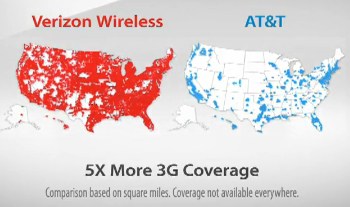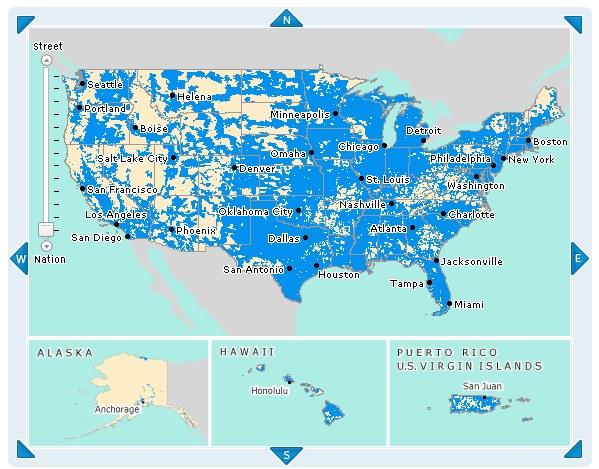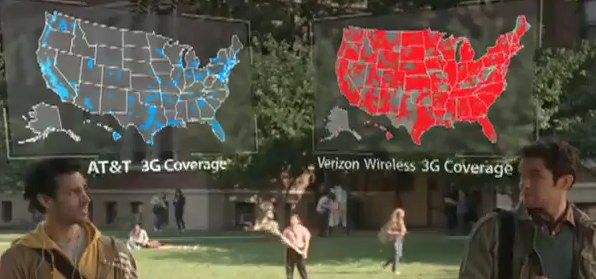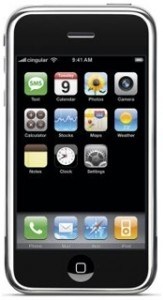[flv]http://www.phillipdampier.com/video/There’s a Map for That 1.flv[/flv]
Verizon’s “There’s a Map for That” Advertising Campaign: Spot 2 (pre-revision — includes “out of touch” language (30 seconds)
AT&T Mobility has filed suit against Verizon Wireless in the Northern District Court of Georgia (Atlanta Division) demanding the court order Verizon to stop running ads that suggest AT&T has lousy wireless 3G data coverage.
The suit comes in response to a series of advertisements from Verizon that compare the coverage maps of both companies “3G” wireless data networks. The term “3G” refers to the third generation (3G) of mobile telephony standards – IMT-2000. In general terms, local wireless networks upgraded to provide 3G service can provide much faster wireless data speeds than those still operating under older standards like “2G.”
Verizon Wireless has aggressively deployed 3G upgrades across its service area, while AT&T has largely focused on more urban population centers for their 3G upgrades, something Verizon’s advertising calls out.
The crux of the suit is exactly how Verizon depicts the differences in coverage.
AT&T claims the ads leave viewers with the impression that those vast white areas depicted on the coverage map designated by Verizon as “AT&T,” are areas without any data coverage at all. Most cell phone company coverage maps routinely depict “no service” areas in white, and AT&T claims Verizon underlined the impression in its ads, including one on radio, that included the phrase “out of touch” when speaking about non-3G AT&T service areas. AT&T described the ad above as showing “a frustrated or sad AT&T customer sitting alone on a bench because she is not able to use her wireless device to meet up with her friends.”
AT&T Mobility’s own coverage map depicts data coverage in varying hues of blue, designating the different types of data service coverage available nationwide, but those different hues and service areas only become apparent after starting to zoom in on specific regions of the country.

AT&T's coverage map changes when you zoom in, depicting the different types of network standards used in different areas. This map of eastern Texas shows coverage ranging from 3G to woefully slow EDGE networks owned by "AT&T partner" companies
On AT&T’s maps, areas in white are labeled “no service available.”
On October 7th, AT&T Mobility contacted Verizon Wireless and demanded that they either cease the ads or modify them to make them, in AT&T’s words, “less misleading.”
In response, Verizon dropped the “out of touch” language from the ads and inserted a fine print disclaimer at the bottom indicating “Voice and data services available outside of 3G areas.”
AT&T considers the modifications inadequate and filed the lawsuit asking for a cessation of the ads and monetary damages from perceived ill-gotten profits from Verizon snatching away AT&T customers.
Verizon’s defense? Accuracy. Verizon Wireless’ ads never stop referring to “3G service” and both maps include specifically labeled “3G Coverage.”
AT&T argues that their network is actually more expansive than Verizon’s, when you also include AT&T’s more prevalent 2G and earlier wireless data standards. But that’s arguing apples and oranges. Verizon intends to promote and leverage benefits from upgrading its service areas, large and small, to 3G service. AT&T has not done that, and in fact has been on the receiving end of criticism from customers frustrated at times with the poor performance of its network, including slow data speeds, dropped calls, and insufficient coverage in certain areas.
The gadget enthusiast press has not been enthusiastic about AT&T’s lawsuit, wishing the company would be as enthusiastic with network upgrades as they are engaging their legal team to fight Verizon, or is little more than a whining villain that has been exposed for its inadequacies.
AT&T customers frustrated with their mobile experience are probably still better off than T-Mobile customers, some of whom spent much of yesterday with no service at all. In the second nationwide outage in two months, T-Mobile claims about two million customers nationwide experienced voice and data service outages for much of the day, although anecdotal reports suggest a company estimate of “five percent of customers impacted” is low. No explanation for the outage was given. This comes after an embarrassing server failure in October which led to some T-Mobile Sidekick customers being without service for up to a month, as well as a loss of stored data which company officials have slowly tried to restore weeks after the system crashed.


 Subscribe
Subscribe




